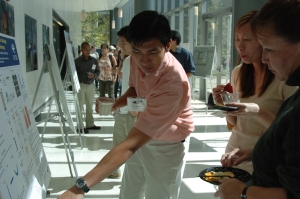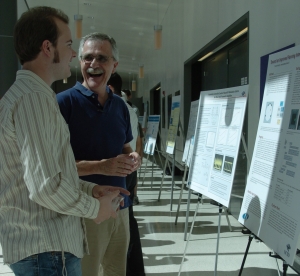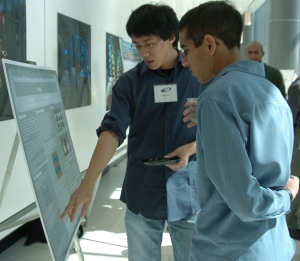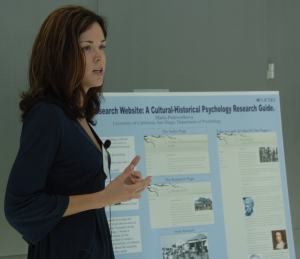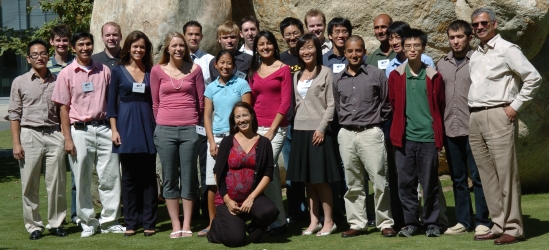Celebrating the 2007 Calit2 Summer Undergraduate Scholars
|
San Diego, CA, October 8, 2007 -- The conclusion of the UCSD division of Calit2's 2007 Summer Scholar program was celebrated with a poster session and informal reception held at Atkinson Hall on Friday, September 21 during UCSD's Welcome Week. The program supports undergraduate researchers while they do hands-on research in dozens of fields with faculty advisors from across campus, for a 10-week period over the summer.
This year's class was the largest ever: 28 scholars. With most of the scholars present and many of their advisors, lab mates and friends, as well as family members and interested visitors in attendance, the first floor Pre-Function area of Atkinson Hall was busy throughout the event.
The scholars contributed to ongoing research activities, or conducted separate projects, in a wide range of fields, reflecting the multidisciplinary mission of Calit2. While a wide spectrum of engineering and computer science fields was represented, half (14) of the awardees were majors in other fields, from biochemistry and microbiology to music, visual arts, cognitive science, psychology and political science.
The high quality of the work performed by the scholars was commented upon by many of the advisors, as well as attendees at the poster session.
|
"The Calit2 Undergraduate Scholar program is a wonderful opportunity for undergraduate students to get involved in real research, typically pursued by graduate (Ph.D.) students," noted Vitaliy Lomakin of Electrical and Computer Engineering (ECE), "I was impressed by many works presented by the participants."
Richard Choi worked in Lomakin's group on developing computational methods in micromagnetics for the analysis of "Reversal Processes in Patterned Media". These media are anticipated to allow constructing next generation hard drives with ultra-high recording densities. "Richard's effort has already resulted in one paper submitted for publication in the Journal of Applied Physics. At least one more paper will be submitted soon to IEEE Transactions on Magnetics. Additional papers are likely to appear later," said Lomakin, "This output is remarkable for an undergraduate student working on such a complicated project for only a few months."
An interdisciplinary cross-section of art, technology and the social environment is the arena where Jason Najarro worked, on the *Transborder Immigrant Tool* project. "Under the flickering signs of our current social condition that flow between the jagged shifts of globalization, technology and post-contemporary culture, it becomes evermore important to have artists, engineers and human beings who can not only understand this condition, but can define, reconfigure and invent new gestures that can push beyond the edges of the future -- Jason Najarro is just such a person," said Ricardo Dominguez of Calit2 and Visual Arts, Jason's advisor, "He approached working on the interface with deep questions and a steady social vision, a strong aesthetic and great technical talent to meet the demands of the project."
Dominguez continued: "Brett Stalbaum and I could not have found a better collaborator than Jason. Because of his excellent work on the project, the research group is now a finalist for the Transnational Communities Award 2007 granted by Mexico/U.S. Foundation for Culture, Inc." [Update: Late today, 10/8/2007, it was announced that they had won the award.]
|
Jason received his bachelor's in Cognitive Science last June and is now working as a user experience designer for a company in San Jose. However, he came back for the day, to be present at the session: "I have a large personal investment in the project and wanted to come down here in order to answer questions that anyone had about it," he explained, "I still plan on being involved with the project."
Deli Wang of ECE, faculty advisor to two students, stated: "I am very proud of both Chris Huynh and Jimmy Kan, who did superb work in my lab this summer. Specifically, Chris worked on the growth and fabrication of nanowire based light emitting diodes - a new concept leading to high efficiency light emitting diodes. He performed a detailed study on the solution growth of nanowires on different substrate with excellent uniformity and coverage, and explored the p-type doping as well, both are critical to LED fabrication. I am very much looking forward his continuing involvement in this project."
"Jimmy is simply excellent! He was involved in two projects, the growth of nanowires and mass alignment using Langmuir-Blodgett method. Jimmy was involved in the growth of copper germanium nanowires and demonstration of nanowire based cryo-resistor, which will be further used for in-situ study of nanowire memory devices that could lead to unprecedented integration of different functions at nanoscale. He also initiated in my group the project of the alignment and transfer of nanowires on substrate using Langmuir-Blodgett method, which is currently still the bottleneck of broad application of nanowires in electronics and optoelectonics industries."
The opportunity to pursue research on a full-time paid basis, without interruption from class work or outside employment, can be a powerful experience for the undergraduate scholars, teaching them what research is really like and very often guiding their career paths.
|
Ji-Won Youm worked on "Genomic Analyses of Transport Proteins in Mycobacterium tuberculosis and Mycobacterium leprae. "I got a real kick out of overcoming the many challenges that came up," he said, "Working with a faculty advisor and the project gave me a sense of what research is like and I really appreciate the intellectual freedom I was given." Ji-Won also noted: "I like how the program was structured, and the seminars, especially the ones on how to conduct research and give effective presentations."
Working closely on a research project with a faculty advisor is an opportunity rarely afforded to undergraduates; the summer scholars make the most of it. Like Jason Najarro and Richard Choi, many of the summer scholars plan to remain connected to their projects, if not still actively working in the lab, continuing their work into the next phase of their project, and in several cases, writing up the results for journal submissions.
Chien-Tze (Jasmine) Huang worked with Davorka Messmer of the UCSD Moores Cancer Center on "Induction of Anti-Tumor Immune Responses Using Silica Nanoparticles." Christine Pai also worked with Messmer, her project was "Nanoparticles for Tumor Immunotherapy." Both enjoyed their summer of research. "Dr. Messmer gave very good guidance for the project, she was very supportive and helpful," noted Jasmine, "This internship provided me valuable experiences and a good opportunity to work closely with such a professor, having an exchange of ideas and feedback. This close interaction was essential to the success and completion of my project."
The event was also an opportunity for prospective scholars and members of the UCSD community to see what kind of research is being conducted at Calit2. Amul Shah, a Regents Scholar and incoming freshman, who plans to major in bioengineering, came because he is interested in doing research and wanted to check out the posters. "I found that there's not one, set way to do a research project and that there are many ideas waiting to be discovered and different ways to get ideas," said Amul, "I feel that if anyone is interested in research, coming to check out the posters is a great idea."
Many of the scholars had short versions of their presentations captured on video. These videos and copies of the students' posters were posted recently: Calit2 Summer Scholar Project Posters and Videos Available
|

